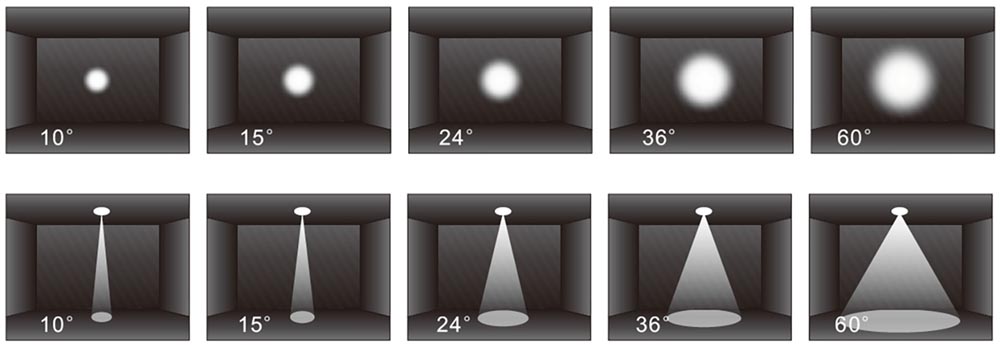How to choose the beam angle of led Spot lights?
What is the beam angle?
Beam angle is something that needs to be taken care of in selecting the appropriate LED lighting for space. The beam angle indicates the spread of light from the light source. Narrow beams provide centralized lighting and are suitable for accent lighting. Wide beams give a more general and softer light.
Most LED lights are available at selected beam angles.
Narrow beam angles, from a very narrow 5-degree spot to a wider 60-degree flood, make the light more intensive and intense. A wider beam angle better distributes light to more areas of the room. Knowing how to use beam angles correctly can significantly improve the lighting effects in a room.

How to choose the beam angle of the LED Spot Downlight?
The light is directed to a specific object or person, and you need to choose a narrow beam angle, not an area. When illuminating a large room etc., it is necessary to select a wide beam angle.
For example,
10° beam angle, concentrated central light intensity, generally used for museum exhibitions.
15° beam angle, concentrated central light intensity, strong contrast in the irradiated surface, can irradiate a small range, used for focus lighting, such as columns, handicrafts or small size of the decorative objects.
24 ° beam angle, spot large can be irradiated range becomes larger, for focus lighting, such as decorative plants, coffee table, dining table.
38° beam angle, centre light intensity is small, the spot is large, used to wash the wall lighting, such as TV background wall, sofa background wall

If you need soft diffuse lightings, such as a led downlight or spot Downlight living room like the following, it is recommended to choose a wide-angle (60°) Spotlight. However, when looking at kitchen downlights, a narrower beam angle (25°) is desirable. This is ideal if you need to provide concentrated light, illuminate the surface and focus on the room details. Whatever the size of the room, it always looks better in the pool of light instead of the dazzling light. It creates more atmosphere in your space. In general, if you do not know which beam angle to choose, most of the 60 to 120 degrees is fine.
Well, I think one is a spacious area. A lounge area is ideal for wide beam angles because it doesn't need to be too bright. The usual work done usually in lounge areas include watching TV, relaxing and reading. Focused or intense on the other hand, narrow beams (about 24 degrees) are suitable for rooms with high ceilings (such as libraries and study rooms). In all other rooms in your home or office, a beam angle of between 35 and 45 degrees is usually appropriate, but this also depends on the distance and purpose of the light.
This is really a matter of personal preference and how you want to focus your light. However, you can refer to the advice above.
For standard ceiling heights (between 2.4 and 2.7 metres), a wide beam spread of 60 degrees or greater is recommended. For ceilings higher than 2.7 metres, a beam spread of less than 50 degrees is recommended and more lights are required.

In summary, select the beam angle: In order to achieve a good light effect, we must choose the angle of illumination.
1. If it is required to flood, the angle of choice needs to be larger, such as 90 degrees, 120 degrees.
2. If it is concentrated, choose a smaller angle, such as 15 degrees, 30 degrees.
3. If you are not sure, you can choose some practical angles, such as 45 degrees, 60 degrees, and 90 degrees

Shenzhen Yuanyeled Co.,Ltd. is a professional company, was established in 2011 based in Shenzhen, China with over 10-year experience in LED lighting industry starting with LED encapsulation.
CONTACT US
Email: rice@yuanyeled.com
Tel: +86-19925346944
WhatsApp: +86-19925346944
ADD: Floor 8th, building 8, Langxia third industrial zone, Songgang town, Baoan district, Shenzhen city, China.












